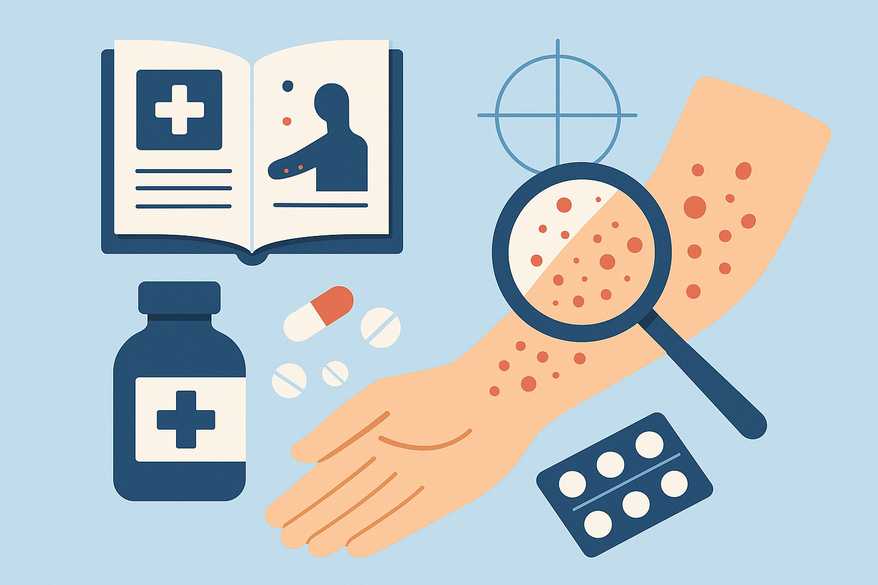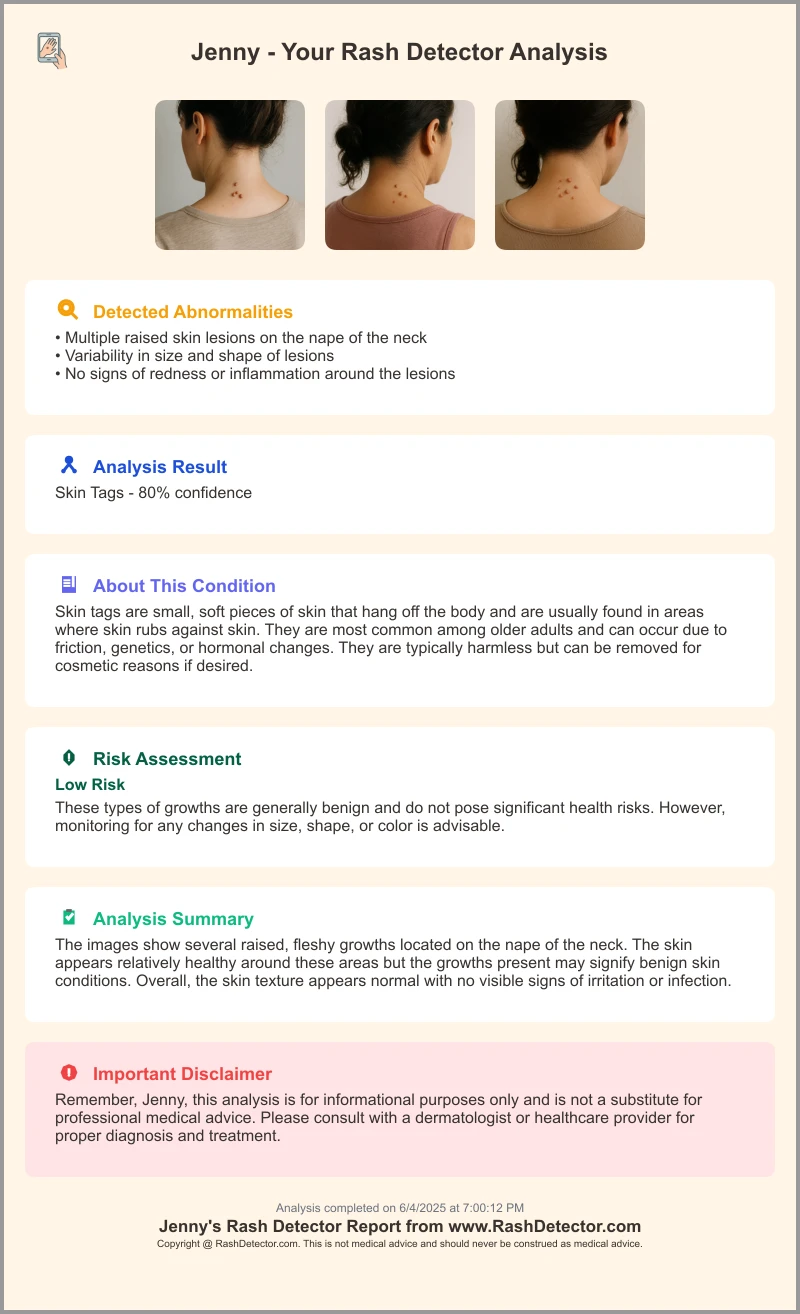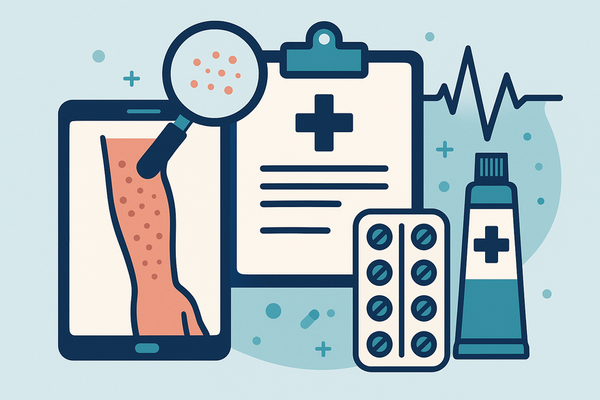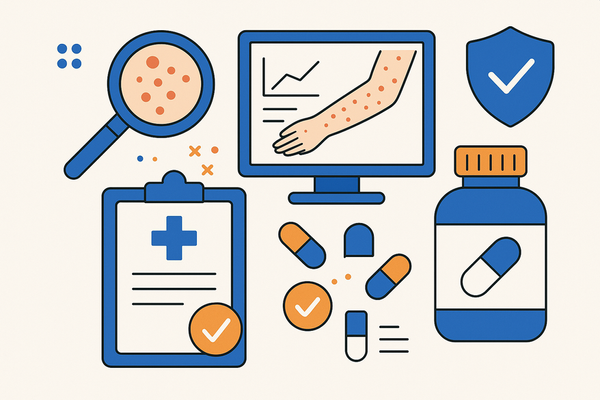Medication Rash Treatment: How to Identify and Manage Drug-Induced Reactions
Learn how to effectively manage and treat medication-induced rashes with our comprehensive guide, ensuring swift recovery and prevention of complications.

Estimated reading time: 12 minutes
Key Takeaways
- Medication-induced rashes arise via immune-mediated or toxic mechanisms.
- Early recognition of symptoms and red-flag signs is crucial for safety.
- Self-care, over-the-counter options, and prescription therapies guide effective relief.
- Daily monitoring and clear communication with healthcare providers ensure proper management.
- Preventative strategies and accurate documentation help avoid future reactions.
Table of Contents
- Introduction
- Section 1: Understanding Medication-Induced Rashes
- Section 2: Recognizing Symptoms and Diagnosis
- Section 3: Overview of Medication Rash Treatment Options
- Section 4: Step-by-Step Guidance on Managing a Medication Rash
- Section 5: Preventative Measures and Long-Term Management
- Conclusion and Recap
- Additional Resources and References
- FAQ
Introduction
Medication rash treatment can be life-changing when you or a loved one breaks out in an unexpected skin reaction. In this guide, we offer clear, evidence-based advice on recognizing and managing medication-induced rashes. A medication-induced rash is an abnormal skin reaction triggered by prescription or over-the-counter drugs. It may be immune-mediated (antibody or T-cell driven) or toxic (direct skin damage). Knowing how to spot warning signs and apply proper treatment steps helps prevent complications and speeds recovery. Medication-induced rashes are a common yet sometimes alarming response to various drugs. This post breaks down causes, symptoms, self-care, professional therapies, and prevention strategies to keep your skin safe.
For instant, AI-based rash analysis with easy photo uploads, consider Rash Detector, a Skin Rash App that generates a detailed sample report.

Section 1: Understanding Medication-Induced Rashes
1.1 Definition and Mechanism
A medication-induced rash is an abnormal dermatologic reaction to a drug. Two main mechanisms cause these rashes:
- Immunologic reactions involve your immune system. Antibodies or T cells identify the drug as harmful and trigger inflammation.
- Non-immunologic (toxic) reactions occur when the drug itself damages skin cells directly.
In both cases, you see redness, bumps, or other changes. Immune responses often lead to hives or widespread eruptions. Toxic reactions tend to be localized and dose-dependent.
1.2 Common Drug Classes
Certain drug categories trigger rashes more often:
- Antibiotics (e.g., penicillins, sulfonamides). These can form haptens—small molecules that bind to skin proteins and provoke immune attacks.
- Anticonvulsants (e.g., carbamazepine, lamotrigine). Metabolic byproducts can be immunogenic.
- NSAIDs (e.g., ibuprofen, naproxen). May inhibit enzymes that regulate skin inflammation.
Being aware of these classes helps you and your provider watch for early signs.
1.3 Types of Medication-Induced Rashes
Medication-induced rashes vary in appearance and severity:
- Morbilliform eruptions: flat, red macules that may merge into larger patches.
- Urticaria (hives): raised, itchy wheals often triggered by histamine release.
- Fixed drug eruptions: round, well-defined patches that recur at the same spot each time.
- Severe reactions (e.g., Stevens-Johnson syndrome): blistering rash with mucosal involvement; can be life-threatening.
Knowing these rash patterns guides prompt recognition and treatment—learn more about recognizing drug-induced rash symptoms.
Section 2: Recognizing Symptoms and Diagnosis
2.1 List of Common Symptoms
- Itching (pruritus) and burning sensations
- Erythematous (red) or purplish patches
- Hives (urticaria) with intense itch
- Localized or generalized swelling (angioedema)
- Blistering or peeling skin
2.2 When to Seek Medical Evaluation
Some warning signs mean you need urgent care:
- Rapid rash spread over large body areas
- Fever or flu-like symptoms
- Mucosal involvement (lips, eyes, mouth)
- Difficulty breathing or wheezing
- Facial, tongue, or throat swelling
These red-flag symptoms may signal anaphylaxis or Stevens-Johnson syndrome (SJS). Call 911 or go to the ER immediately if you see them.
2.3 Risk Factors for Severe Reactions
- History of drug allergies or eczema (atopy)
- Polypharmacy (taking multiple medications)
- Autoimmune conditions (e.g., lupus)
- Age extremes (young children, seniors)
Always share your full medication and allergy history with providers. It helps them choose safer alternatives.
Section 3: Overview of Medication Rash Treatment Options
3.1 Immediate Self-Care Measures
- Discontinue the suspected drug under physician guidance.
- Apply cool compresses or take cool showers to soothe inflamed skin.
- Use fragrance-free, hypoallergenic moisturizers to restore the skin barrier.
- Avoid scratching; trim nails short or wear soft mittens to prevent breaks in the skin.
3.2 Over-the-Counter and Prescription Therapies
Therapies range from simple antihistamines to emergency epinephrine:
- Antihistamines: Cetirizine 10 mg once daily or diphenhydramine 25–50 mg every 6 hours reduces itching.
- Topical corticosteroids: Hydrocortisone 1% cream twice daily for mild, localized rashes.
- Oral corticosteroids: Prednisone 0.5–1 mg/kg/day tapered over 5–7 days for moderate-to-severe eruptions.
- Epinephrine auto-injector: 0.3 mg intramuscularly for adults in anaphylaxis. Keep one on hand if you’ve had severe reactions.
Follow dosing advice from your healthcare provider. For more in-depth guidance on managing drug allergy rashes, see managing drug allergy rashes.
3.3 Home Remedies and Lifestyle Interventions
- Wear loose, breathable cotton clothing to reduce friction.
- Keep a symptom and trigger diary: note drug start date, rash onset, and changes.
- Inform all health professionals and your pharmacy about documented drug allergies.
Section 4: Step-by-Step Guidance on Managing a Medication Rash
Step 1: Daily Monitoring
- Photograph and measure the rash area each day.
- Log pain and itch intensity on a 0–10 scale.
- Note any new symptoms (fever, breathing changes).
Step 2: Consult Healthcare Provider
- Share your diary and photos at appointments.
- Ask about safer drug alternatives or desensitization protocols.
- Do not abruptly stop critical medications without medical advice—some require tapering.
Step 3: Escalation Protocol
Call 911 or head to the ER if you see:
- Rapid facial or tongue swelling
- Airway compromise or difficulty breathing
- High fever (>38 °C) with rash
- Widespread blistering or skin peeling
Step 4: Ongoing Skin Care
- Hydrate: aim for 8–10 cups of water daily to support skin healing.
- Use fragrance-free, dye-free detergents on clothes and bedding.
- Avoid hot baths or harsh soaps; choose gentle, pH-balanced cleansers.
Section 5: Preventative Measures and Long-Term Management
5.1 Pre-Medication Precautions
- Review your full medication and allergy history with every provider.
- Ask about cross-reactivity within drug classes (e.g., penicillins vs. cephalosporins).
- In select cases, desensitization protocols allow safe use of needed medications.
5.2 Documentation and Alerts
- Carry a printed or digital list of drug allergies and reaction details.
- Wear a medical alert bracelet or set up a smartphone allergy profile.
5.3 Follow-Up Care
- Schedule dermatology or allergy consults for patch testing if rashes recur.
- Review your medication list at least once a year, especially with new specialists.
- Update your allergy records after any new reactions or test results.
Discover expert prevention tips at prevent-recurring-rashes tips.
Conclusion and Recap
Early recognition, correct diagnosis, and prompt medication rash treatment help stop discomfort and avert serious complications. Key steps include discontinuing the offending drug, applying self-care measures (cool compresses, moisturizers), and using appropriate pharmacotherapy (antihistamines, corticosteroids, or epinephrine when required). Daily monitoring and clear communication with healthcare professionals ensure safe management. Carrying accurate allergy records and following preventative advice protect you from future reactions. With this step-by-step guide, you can confidently identify, manage, and prevent medication-induced rashes.
Additional Resources and References
- Mayo Clinic: Drug allergy – Diagnosis and treatment
- DermNet NZ: Drug eruptions
- Healthline: Drug rash and eruption – Symptoms, causes, and treatment
- Becker ENT & Allergy: Strategies for managing drug allergy rash
- NYU Langone: Medication for drug reactions and hives
FAQ
What are common symptoms of a medication-induced rash?
Common signs include itching, red or purplish patches, hives, swelling, and sometimes blistering or peeling skin.
When should I seek emergency care for a drug rash?
Seek immediate help if you experience rapid spread, fever, mucosal involvement, difficulty breathing, or facial swelling—these could signal anaphylaxis or SJS.
Can I continue taking my medication if a rash appears?
Never stop critical medications abruptly without consulting a healthcare provider. They may need to taper safely or recommend alternatives.
How can I prevent future drug-induced rashes?
Maintain thorough allergy documentation, discuss cross-reactivity with your provider, consider desensitization protocols if needed, and carry an allergy alert profile.





